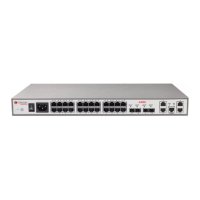A10E/A28E/A28F Configuration Guide
Figure 7-8 Loop networking with STP
Although STP can eliminate loop network and prevent broadcast storm well, its shortcomings
are still gradually exposed with thorough application and development of network technology.
The major disadvantage of STP is the slow convergence speed.
RSTP
For improving the slow convergent speed of STP, IEEE 802.1w establishes Rapid Spanning
Tree Protocol (RSTP), which increases the mechanism to change interface blocking state to
forwarding state, speed up the topology convergence rate.
The purpose of STP/RSTP is to simplify a bridge connection LAN to a unitary spanning tree
in logical topology and so as to avoid broadcast storm.
The disadvantages of STP/RSTP are exposed with the rapid development of VLAN
technology. The unitary spanning tree simplified from STP/RSTP leads the below problems:
The whole switched network has only one spanning tree, which will lead to longer
convergence time in a larger network.
Waste of bandwidth since a link does not carry any flow after it is blocked;
Packet of partial VLAN cannot be forwarded when network structure is unsymmetrical.
As shown below, Switch B is the root switch, RSTP blocks the link between Switch A
and Switch C logically and makes that the VLAN 100 packet cannot be transmitted and
Switch A and Switch C cannot communicate.

